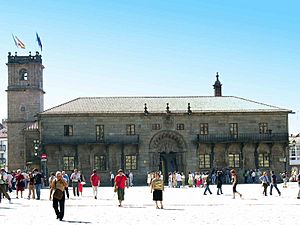Alonso III Fonseca facts for kids

Alonso III Fonseca (born in Santiago de Compostela in 1475, died in 1534) was an important person from Galicia. He was a powerful archbishop (a high-ranking church leader) and a smart politician.
He became the Archbishop of Santiago de Compostela in 1507. Later, in 1523, he became the Archbishop of Toledo, which was a very important position. Alonso III Fonseca was a big supporter of the University of Santiago de Compostela, helping it grow and become strong.
His father was Archbishop Alonso II Fonseca, and his mother was María de Ulloa. Alonso III had an older brother named Diego II de Acevedo, who was the first Count of Andrade. They had different last names because in those days, a younger son like Alonso III would often use his father's last name ("Fonseca"). An older son might use the last name of his grandmother, which was "Acevedo" in this case.
Contents
Early Life and Role as Archbishop
As an archbishop, Alonso III Fonseca had to deal with powerful nobles, like the Count of Altamira. This count was trying to control areas known as the Tierras de Santiago. Fonseca used his good connections with the Spanish king and the Pope to stop these injustices.
He also had legal disagreements with the Benedictine monks of San Martín Pinario. This was happening when the Benedictine religious group was becoming very strong again in Galicia.
In 1512, Alonso III Fonseca led the funeral for his father. A famous military leader, Gonzalo Fernández de Córdoba, known as "The Great Captain," attended. As a sign of respect, Fernández de Córdoba offered his weapons to Saint James the Great (Santiago) at the funeral.
Political Career
Alonso III Fonseca became a leader for the Galician nobility (important families). They wanted to keep their special rights and powers. Emperor Charles V even made Fonseca a member of the Royal Council, which was a group of advisors to the king.
The Galician nobility was not allowed to be part of the Cortes (a type of parliament or legislature) meetings in Santiago and A Coruña. Fonseca led the fight to get them included in these important meetings. He also led a meeting in Melide. At this meeting, they asked for Galicia to have its own representatives in the legislature. They also wanted a new casa de contratación (a special trading office) in A Coruña. Fonseca also helped to calm things down during the War of the Germanías, which was a conflict in Spain.
Archbishop of Toledo
In 1523, Alonso III Fonseca was chosen to be the Archbishop of Toledo. This was a very high position in the church. In this role, he supported many scholars, artists, and humanists (people who studied human culture and values).
He had the honor of baptizing Philip II of Spain in May 1527. Philip II later became a very famous king of Spain. Alonso III Fonseca mostly lived in Alcalá de Henares, where he passed away on February 4, 1534. He was buried in Salamanca.
Alonso III Fonseca had a son with a noblewoman named Juana de Pimentel. His son later worked for the Spanish king and inherited land in Galicia.
His Lasting Impact
The University of Santiago de Compostela truly became strong and important because of Alonso III Fonseca. He was a very learned man, a true "Renaissance man" who knew a lot about many different subjects. He supported many artists of his time and was in touch with important thinkers like Erasmus of Rotterdam.
Around 1507, an old hospital for pilgrims in Santiago de Compostela was bought. The plan was to turn it into a university college. The Santiago Alfeo College, now known as the Fonseca College, was also built. This college became the main center of university life until the late 1700s. It is still a very important building at the university today.
See also
 In Spanish: Alonso de Fonseca y Ulloa para niños
In Spanish: Alonso de Fonseca y Ulloa para niños



